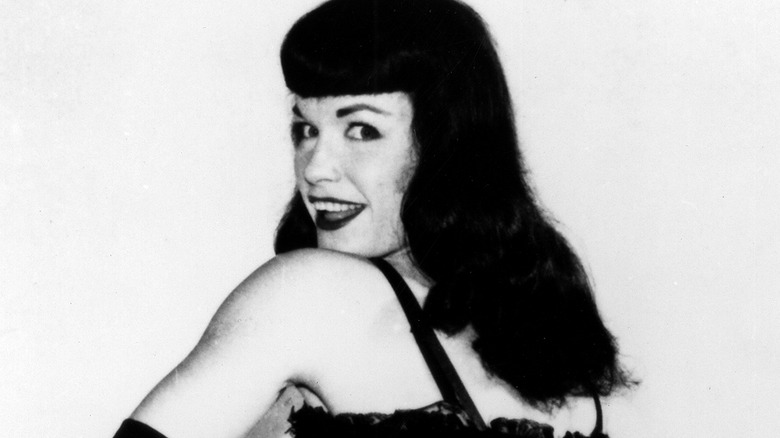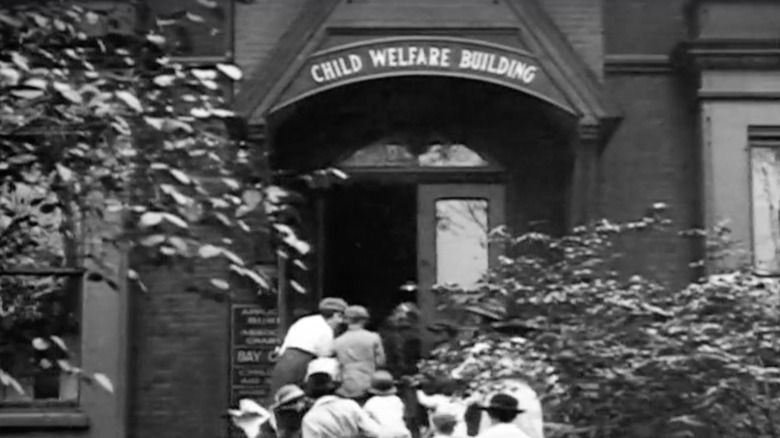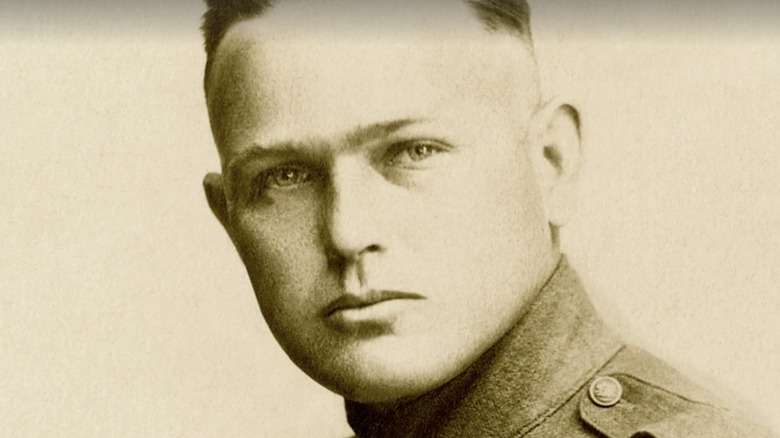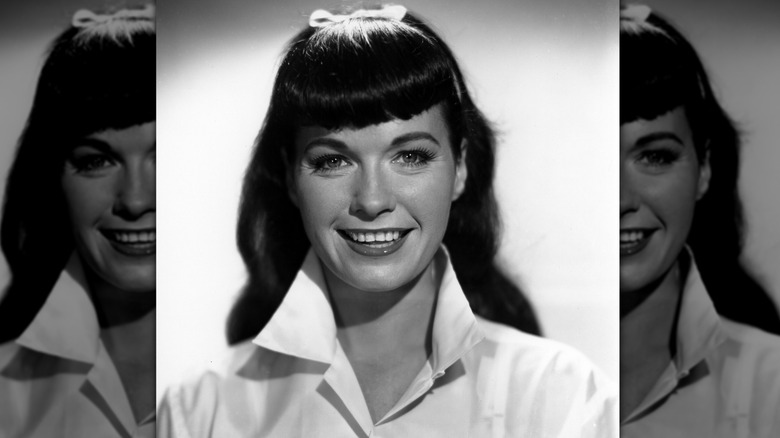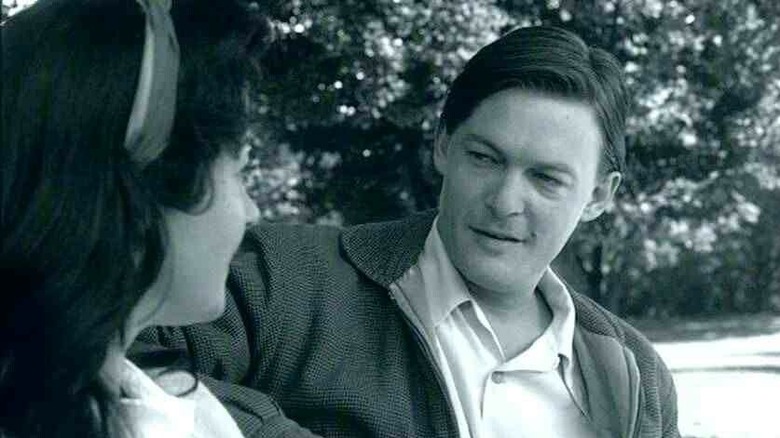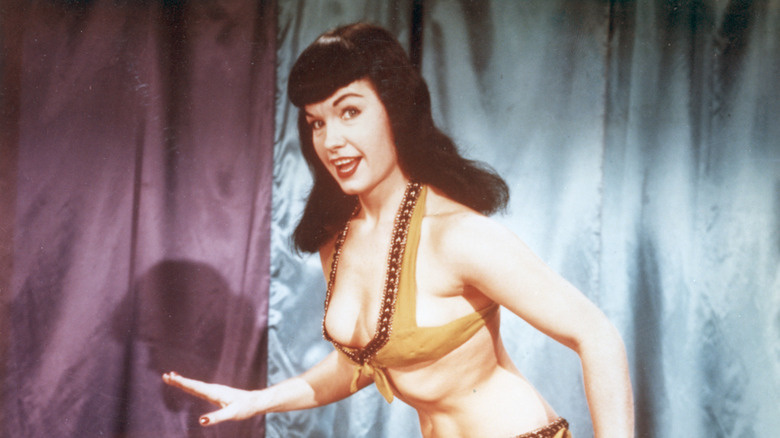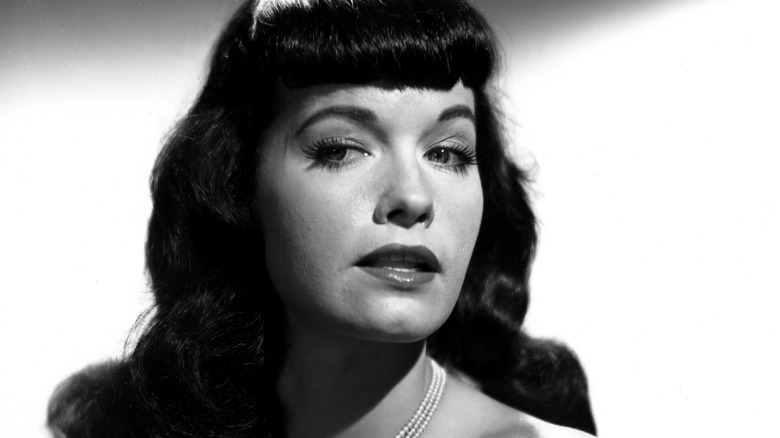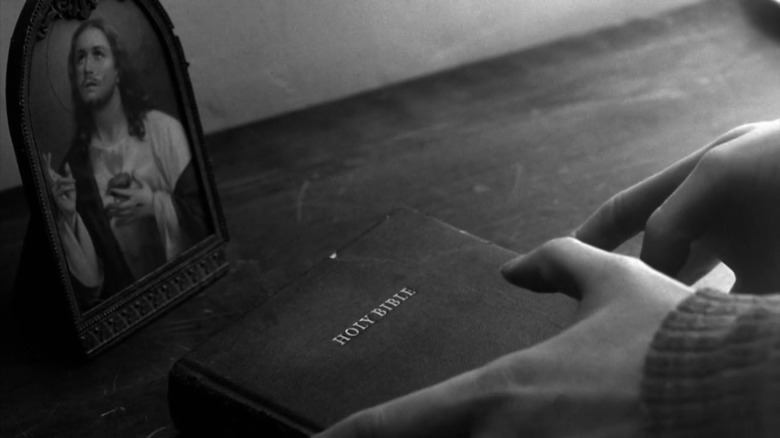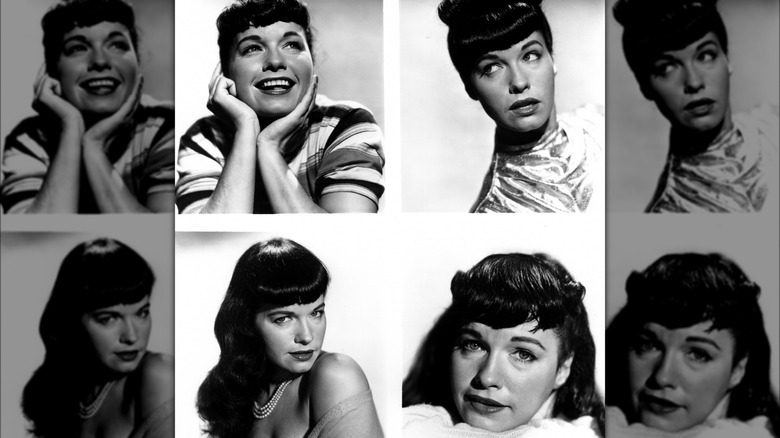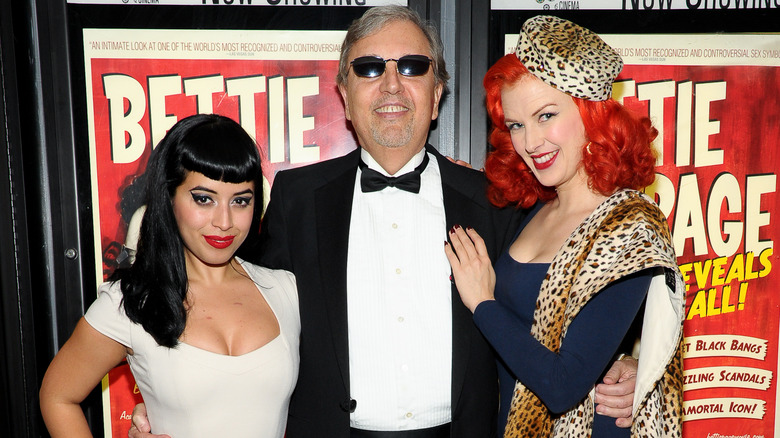The Tragic Real-Life Story Of Bettie Page
Bettie Page epitomized the 1950s in an entirely different way to Marilyn Monroe and Elvis Presley, and despite outliving them by almost half a century, has an even more tragic life story. And though she went missing for most of that half-century, she arguably had a more significant and lasting impact on popular culture.
At the center of Page's legacy is her status as the Queen of Pin-ups. Seventy-five years after her heyday, indelible images of the brunette-banged model continue to influence the realms of beauty, fashion, music, and comics. But, though she exuded carefree, self-possessed sexuality, she was also a victim — and perpetrator — of violence. Behind Page's ebullient smiles and poses was a real woman who faced hardship from birth to death, often alone.
There's already been a biopic made about Page's pin-up fame and personal demons; 2005's "The Notorious Bettie Page" starring Gretchen Mol, the title of which the subject of the film didn't quite care for when Hugh Hefner screened it at the Playboy Mansion. Page's actual life, which was further explored in several biographies and a documentary, wasn't exactly (at least only) notorious. It was complicated, worthy of celebration and scrutiny, and ultimately unnecessarily sad.
The following article includes allegations of child abuse, domestic abuse, and sexual assault.
Her unhappy childhood included time in an orphanage
Bettie Page's life was destined to be tragic before it even began. In the documentary "Bettie Page Reveals All," directed by Mark Mori, the pioneering pin-up laments the strained relationship she had with her mother, who largely neglected Bettie; she failed to prepare her for puberty and adulthood, and missed milestones like school plays and graduation.
To be fair, Edna's life was just as tough as Bettie's, but without the eventual fame. The family was extremely poor and moved often. Food was scarce. Bettie said she was lucky to get an orange in her Christmas stocking, and Edna's husband, Walter, once served time in prison for car theft.
Life became even more difficult for Bettie once her parents divorced after her "sex fiend" father impregnated a teenager. Having only been educated through third grade and having few marketable skills, Edna struggled to care for her children. When Bettie was around 11 years old, her mother placed her and her sisters in an orphanage. The three girls spent a year in a Protestant-run facility, where the young children were treated poorly and expected to perform laborious chores, such as scrubbing the floors. "We just hated that place," Page told Mori. "I was so glad to get out of there."
She endured horrific sexual assaults
Walter Page wasn't just a "womanizer of the worst sort," as Bettie Page called her father. In "Bettie Page Reveals All," she describes the extent of his depravity and cruelty. "He'd have sex with anything he could get his you-know-what into," she told the documentary's director, Mark Mori. This included livestock (Bettie lists off chickens, sheep, and cows). It also included her two sisters, whom Walter raped after he and Edna Mae reunited.
Page's father molested her too, but she was able to exert some control over the awful situation. Beginning at about the age of 13, Page would negotiate sex acts with her father. For ten cents, which she spent going to the movies, she'd let him fondle her "on the outside." Of course, no child can truly consent to being sexually abused for any price, and what Page went through as a young teenager was traumatic.
Some years later, when trying to make her way in New York City, Page would become the victim of a violent sexual assault. She recounted to Mori how she loved to go dancing. On one occasion, a handsome and seemingly gentlemanly stranger asked her if she wanted to join him. She said she'd love to. When they stopped to pick up four more men, Page began to feel that something was amiss. She was struck in the head and taken behind a school building, where five men attempted to rape her. Page told them she was menstruating, but that only mitigated the attack. All five forced themselves upon her, and she was afraid she'd be killed or left for dead.
A quarter of a point cost her a better life
Despite the poverty, instability, neglect, and abuse she faced as a child, Bettie Page was an upstanding student. She was voted most likely to succeed by her peers in her senior class yearbook. She was also a member of the debate team, the program director of the drama club, secretary-treasurer of the student council, and co-editor of the school newspaper. But Page was most proud of the fact that her intelligence and good study habits had landed her at the top of her class. Her dream was to be valedictorian, which came with a full four-year scholarship to nearby Vanderbilt University, where the tuition would've been prohibitively expensive for Page's family.
Unfortunately, she was sent to live with her abusive father as her high school finals approached. Her mother Edna blamed her for an incident where Edna's younger lover tried to wrestle Bettie into his car, and, incensed, Edna sent Bettie away, forcing her to leave her exam notes behind.
"I studied so hard," Page said, "but I was beat out of valedictorian by one-quarter of a point." Instead, as she regretfully related to director Mark Mori in "Bettie Page Reveals All," "All I got was a $100 scholarship to George Peabody College for teachers." She earned a bachelor of arts in 1944, but she spent much of the next decade looking for purpose. She took various secretarial jobs, but she turned her attention to a potential career as a model or actress — and to the charming "sports hero" from the next town over, Billy Neal. Had she attended Vanderbilt, Page may have avoided the pain and heartbreak that awaited her. She called this missed opportunity "the worst disappointment of my life."
Her first marriage ended with death threats
Bettie Page and Billy Neal (played by Norman Reedus in "The Notorious Bettie Page," pictured above) had been happily dating when the United States became involved in World War II. Neal was drafted into the army and, in Page's words to director Mark Mori in "Bettie Page Reveals All," began "bugging" him about getting married. The young couple eloped, but Page had second thoughts almost immediately. On the bus ride home from the courthouse, she wondered to herself, "What have I done?"
When Neal returned from the battlefield, Page realized that he had what she termed "battle fatigue" and was a changed man, which manifested as jealousy and rage. Page tried her best to make the marriage work, but his paranoia about her perceived infidelity — he accused his wife of being unfaithful with what he imagined to be "every sailor in San Francisco" — led to threats of violence. Page described how he once held a knife to her neck in their kitchen and promised to use it if she ever divorced him. "I divorced him anyhow," she defiantly told Mori.
She struck out on her own, but Neal followed. He showed up at her apartment one night around midnight, announced himself, and demanded to be let in. Her next-door neighbor and friend, a 50-year-old man named Jimmy, came to her defense, and Neal slashed him across the face with the knife he'd intended to use on Page. She believed he was planning on killing her.
Pin-up fame landed her in hot water with Congress
Bettie Page's journey from wannabe model and actress to Queen of Pin-ups began when a police officer named Jerry Tibbs offered to make her a portfolio if she posed for him. She agreed, and surprisingly, Tibbs turned out to be a legitimate photographer. From there, Page became a favorite of the amateur Camera Club circuit. She frequently collaborated with photographers Irving and Paula Klaw as well as Bunny Yeager, and she was a Playboy centerfold.
In director Mark Mori's "Bettie Page Reveals All," Page points out that none of these men and women ever "made a pass" at her. Though they were creating provocative images, they weren't creating pornography. Page wasn't pictured with men and the poses were carefully staged. Yet, as she became more popular, she came under heightened scrutiny from Congress. Out of fear her photos for Klaw (especially those involving BDSM and suggested lesbianism) were corrupting the youth, a committee to address juvenile delinquency was convened in 1955, and Page was subpoenaed by Senator and moral panic-peddler Estes Kafauver to testify against her publisher.
Kafauver's evidence? A boy scout had been discovered hanging from a tree. His death was blamed on his supposed viewing of Page's bondage modeling. As a result of the hearing, many of Page's photographs were destroyed, and she walked away from the camera. Ironically, she noted that conservative doctors, lawyers, and politicians had been some of the clients who'd paid Klaw for Page's pictures. Nonetheless, she faded into obscurity for almost three decades.
Domestic bliss continued to elude her
The family in which Bettie Page grew up was deeply dysfunctional, and sadly, she was never able to establish a happy, functional family unit of her own. But it wasn't for lack of trying. Page was married four times to three men and had at least two other serious love interests. Every one of these relationships ended in disappointment or disaster. Page said of herself in the documentary "Bettie Page Reveals All," "If ever I've been stupid about anything in my life, it's about where men are concerned."
The love of her life was a man named Carlos Garcia. He was an excellent dancer and lover, but a dishonest boyfriend. Page hadn't known he was actually married until Garcia's wife caught them. Once she'd become famous, Page dated well-known industrial designer, Richard Arbib. Arbib was separated from his wife at the time, and his and Page's affair was quite public. He even commissioned a custom watch for her, but he left her to give his marriage a second chance. In 1958, she married a man named Armond Walterson, who was 12 years her junior. Walterson was more interested in booze and hamburgers, and their union ended as hastily as it had begun.
After an ill-advised second wedding to Billy Neal, Page married Harry Lear in 1966. By this time, she was living out of the spotlight. Lear, a divorcee, had kids already, which appealed to Page, who couldn't bear children of her own. Page had what looked like a traditional domestic life for the first time. In truth, it was anything but: The couple split after Page's worsening mental health and intensifying religiosity became overwhelming.
A religious conversion brought on a nervous breakdown
Bettie Page had always been a believer. She reconciled her beliefs with her profession by reminding people that God had created Adam and Eve in the nude. She didn't believe that the naked body was, in and of itself, a thing to be ashamed of, which is reflected in the joyousness of much of her work. But Bettie became more religious after her marriage to Armond Walterson began to fizzle. She found herself in a church and, in her words, turned herself over to the Lord (per the LA Times).
Shortly thereafter, Page began working as a counselor for Billy Graham. She went back to school, this time to study the bible, with the goal of becoming a missionary. However, her divorce made her ineligible for the job. Page remarried her violent and jealous first husband, Billy Neal, in hopes that she'd be accepted by her fundamentalist church community, which had already prohibited her from partaking in her two favorite pastimes: dancing and watching movies. It was all for naught. Within a month, Neal nearly strangled Betty to death. The marriage was annulled after a month, Page dropped out of school four credits short of a master's degree and gave up on her dream of spreading the gospel in an official capacity.
What stuck was Page's newfound fervor for her Christian faith. Her third husband, Harry Lear, grew concerned about her fanaticism. Page herself admits that she began hearing the voices of God, angels, and the devil. These auditory hallucinations kept her from sleeping and eating, and as Page puts it in the documentary "Bettie Page Reveals All," her mind snapped.
Violent delusions robbed her of her freedom
Journalist Richard Foster published the book, "The Real Bettie Page," in 1997. Its release marked the first time the general public learned about what another biographer, Tori Rodriguez, dubbed Bettie Page's "lost years."
In an interview with Playboy, Page was asked about Foster's allegations that she had forced Lear and his three children to pray to a painting of Jesus Christ, while she kept them at knifepoint. Page disputed some of the facts, but admitted that she had scared Lear and the kids, thrown a plate at them, and spent four months in Jackson Memorial Hospital, where she was prescribed Thorazine.
Page's brushes with the law didn't stop there. Though various reports contain contradictory details (which Mark Mori and Rodriguez discuss as hosts of "The Official Bettie Page Podcast"), it's been established that Page attacked two different landladies with knives, in 1979 and 1982. Both survived, and she avoided charges of assault with a deadly weapon after the first altercation and attempted murder after the second by pleading not guilty by reason of insanity. In total, she spent about a decade confined in Patton State Psychiatric Hospital. By this point, Page had been diagnosed with paranoid schizophrenia, and these disturbing acts were determined to have been related to the religiously tinged hallucinations she was experiencing. Rodriguez explains that Page — who was living alone in trailers and boarding houses at the time — likely went decades without adequate mental health treatment.
She spent her later life destitute and self-conscious
During the time Bettie Page spent in and out of marriages and mental institutions, she became a pop cultural phenomenon all over again ... without knowing or profiting from it. A new and devoted fan base began to form, due in part to the fact that many of the remaining photographs of her were in the public domain. There were Bettie Page conventions. The comic book and subsequent movie, "The Rocketeer," was based on her persona. The aesthetic she had created was a major influence on performers like Madonna, Dita Von Teese, and Katy Perry, fashion designers like Jean Paul Gaultier, Dolce & Gabbana, and Vivian Westwood, and countless women who emulated her alternative rockabilly style and confident sexuality.
But back in the outskirts of Los Angeles, after her release from Patton State in 1992, Page was anything but confident. When director Mark Mori met her in 1996, she was a penniless recluse who lived in a halfway house. Mori and Hugh Hefner helped Page recover financially, but she was too self-conscious to fully enjoy her resurgent celebrity. Though Mori describes her as still gorgeous and still with her bangs in her 70s and 80s, Page repeatedly refused to appear on camera, for him or anyone else, and she largely didn't attend events at which she was being honored. She said she wanted to preserve her image as it had been in the 1950s.
Page returned to Patton State for physical and psychiatric care in 2007, and died a week after a heart attack in 2008. Very few photographs of her life post-modeling career exist. In one of the last, she's pictured with another tragic pin-up, Anna Nicole Smith.
If you or anyone you know needs help with mental health issues, or may be the victim of child abuse or sexual assault, contact the relevant resources below:
-
The Crisis Text Line by texting HOME to 741741, call the National Alliance on Mental Illness helpline at 1-800-950-NAMI (6264), or visit the National Institute of Mental Health website.
-
The Childhelp National Child Abuse Hotline at 1-800-4-A-Child (1-800-422-4453) or contact their live chat services.
-
The Rape, Abuse & Incest National Network website or contact RAINN's National Helpline at 1-800-656-HOPE (4673).
